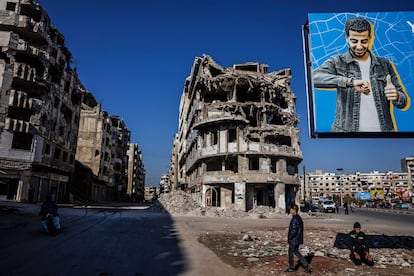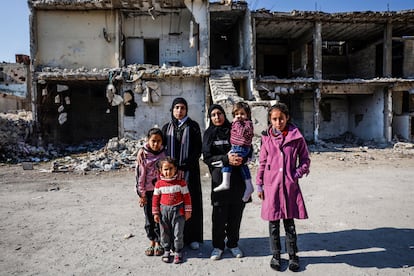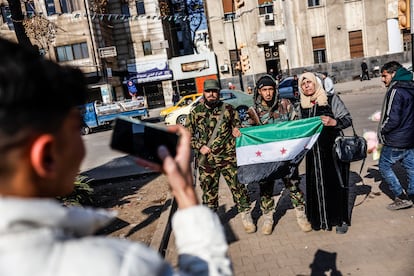Syria’s reconstruction put to the test in Homs, the martyr city
The country’s industrial capital, a religious melting pot and a strategic crossroads, is trying to rise from the devastation with which the regime punished this opposition stronghold

Not even the tombstones in the cemeteries are still standing in Bab Amro, the stronghold of the insurgency against Bashar al-Assad in Homs. It could be the Ohio of Syria, the average province shared by Sunni Muslims (70% of the population), Shiite Alawites (20%) and Christians (10%) for centuries, but the industrial capital of the Arab country has become a martyr city, a symbol of the barbarity with which the regime punished its own people. “I had to look for food in the garbage for three years so as not to die of starvation, like other residents,” says Abdul al-Mulhen, 70, of the long siege to which the army subjected Bab Amro until 2015, under artillery fire and barrel bombs dropped from helicopters. “Without food or medicine, we were in a hell in which it was better to die,” recalls this retired state official, by the warmth of a barrel where a little firewood burns at the minibus stop. Among the rubble, skeletons of buildings stand out, where those who never left Bab Amro, like Al-Mulhen, barely survive.
Syria’s third-largest city, a central crossroads between Damascus (100 miles to the south) and Aleppo, between the Mediterranean coast and the desert interior, has lost 40% of its 1.2 million inhabitants, including its suburbs. Like the rest of the country, the gross domestic product of the once prosperous Homs has plummeted by 50% over the past decade, the World Bank estimates.
In a decade of complete control of the city, the regime barely touched the reconstruction of Homs. Shortly after its overthrow, the titanic task fell to the new authorities. The Islamist militiamen who prevailed over the regime two weeks ago have been re-enlisted as security guards, like Hussein al-Hayan, 31, who boasts that he has been a police officer for “three days.” Sheikh Shamir al-Homsi is the interim mayor. This Sunni cleric, who came from the rebel stronghold of Idlib (northwest) with the Hay’at Tahrir al-Sham (HTS) militia, concentrates all power, military and civil, but is not present in the mayor’s office or official residence. No one can find him.
“We have detailed plans to rebuild the neighborhoods destroyed during the war, with blueprints and budgets, but I can’t say how much it will cost. The Syrian pound is not what it used to be,” explains Abdallah Albouab, 62, the head of the municipal administration. When the war began, the local currency was exchanged at 50 Syrian pounds to the dollar. Now, between 12,000 and 14,000 pounds are handed over. “We don’t have the means to rebuild Syria either,” he admits, “and without some kind of Marshall Plan for international investment, we will never get through it.”
In the post-Assad era, electricity and gasoline are in short supply and large wads of cash are needed to pay for everyday purchases. Syria’s new Islamist leaders, who have come to power by force of arms from a past bordering on jihadism, prefer to remain in the shadows. This saves them from having to answer questions from the foreign press about whether they plan to ban the sale of alcohol, or impose the wearing of the Islamic veil on all women. Senior officials are for now showing their face in the new Syria.
“Our goal is to make Homs a normal city again,” Albouab says of the transitional municipal program. Compared to other large Syrian cities, such as Daraa in the south, or Damascus and its suburbs, the apparent remoteness of the war since 2015 is palpable in the city center, such as the iconic Clock Square — still the scene of celebrations over the fall of the regime — and the surrounding shopping streets. Waving the new national flag, 27-year-old doctor Bilan al-Zabak has undertaken a round trip, like seven million other internally displaced people due to the conflict. He had to leave Eastern Ghouta, in the Damascus region, after the chemical attack in 2013, and escaped to Idlib. “I have returned to visit my parents for the first time in 11 years,” he explains in the same square, “but my life and my family are now in the north, where I am now heading again.”

Among the more than five million Syrian refugees in neighboring countries, sisters Ashia and Yasmin Kabaji, with five children at 36 and six children at 34, respectively, have just returned to the desolate district of Bab Amro, from where they left 12 years ago. “We have already been able to send them all to school,” says the eldest of them. “In the camp in Lebanon, just across the border, we couldn’t make a living. Our husbands are still in Beirut, working at whatever they can, but they will be back soon,” says the youngest. Their home is still partially standing. For the moment, they have been taken in by relatives who are waiting to be able to rehabilitate the house. “It is still uninhabitable, but we are better off in Syria,” agrees Yasmin. “We just need God to send us peace and freedom,” says Ashia.
Of the 190,000 inhabitants counted in Bab Amro in 2011, only a fifth remain in the former rebel stronghold, although hundreds of them are returning every day from the diaspora in a ritual of reunion. First they locate their living relatives, then the graves of the dead, and then they check whether their houses are still standing. The reconstruction of Syria is already being put to the test in Homs, where the absence of essential services is hampering the return of refugees who want to resettle in their country, even in a half-ruined house.
Civil servants earn less than $30 a month, and salaries in the private sector are not much higher. Multiple jobs are the norm. Ninety percent of the population lives below the poverty line, and one in four Syrians lives in extreme poverty, in a country where the monthly income required to support a family is estimated at between $200 and $300. To prevent the new Syria from collapsing from starvation, the new authorities have promised to increase wages from January. The economic crisis in Lebanon, where many Syrians had deposited their savings during the war, and the control of the oil fields by the Kurdish militias, backed by Washington, have emptied the coffers of a country ruined by more than a decade of conflict. Without the lifting of sanctions imposed on the regime by the U.S. and the EU, the country’s ecomony is unlikely to be revived. Among many other things, more than 8,000 schools must be rebuilt and a third of the health system put back into operation if Syria is to stop being a failed state.

The cost of rebuilding Syria will be enormous. The Central Bank has confirmed that the 26 tons of gold (equivalent to about $2.2 billion) deposited in its vault in 2011 are still intact, but only a couple hundred million dollars remain of the $14 billion in foreign exchange reserves then held by the International Monetary Fund. Estimates in 2020 suggested that at least $250 billion would be needed to repair the most serious damage from the war.
“With the money I saved in Lebanon, I will rebuild my house in Bab Amro. But first I have to go back to Sidon to find my wife and five children and sort out my affairs,” says Ahmed Bizan, a 44-year-old truck driver who has also returned to Bab Amro. “I hope that together we can build a new Syria,” he adds, “because without democracy and prosperity we will have to leave Homs again.”
Sign up for our weekly newsletter to get more English-language news coverage from EL PAÍS USA Edition
Tu suscripción se está usando en otro dispositivo
¿Quieres añadir otro usuario a tu suscripción?
Si continúas leyendo en este dispositivo, no se podrá leer en el otro.
FlechaTu suscripción se está usando en otro dispositivo y solo puedes acceder a EL PAÍS desde un dispositivo a la vez.
Si quieres compartir tu cuenta, cambia tu suscripción a la modalidad Premium, así podrás añadir otro usuario. Cada uno accederá con su propia cuenta de email, lo que os permitirá personalizar vuestra experiencia en EL PAÍS.
¿Tienes una suscripción de empresa? Accede aquí para contratar más cuentas.
En el caso de no saber quién está usando tu cuenta, te recomendamos cambiar tu contraseña aquí.
Si decides continuar compartiendo tu cuenta, este mensaje se mostrará en tu dispositivo y en el de la otra persona que está usando tu cuenta de forma indefinida, afectando a tu experiencia de lectura. Puedes consultar aquí los términos y condiciones de la suscripción digital.
More information
Archived In
Últimas noticias
Chris Martin, Taylor Swift, Elijah Wood and other famous wedding ‘crashers’
‘How does it feel to be a failure?’: Elizabeth Berkley’s journey from ‘Showgirls’ ridicule to vindication
The story of the Málaga virus: The code that haunted Google’s cybersecurity center director for 30 years
The impact of Ecuador’s mega-prison: A polluted river, cleared forests and military checkpoints
Most viewed
- Christian Louboutin: ‘Young people don’t want to be like their parents. And if their parents wear sneakers, they’re going to look for something else’
- The low-cost creative revolution: How technology is making art accessible to everyone
- Liset Menéndez de la Prida, neuroscientist: ‘It’s not normal to constantly seek pleasure; it’s important to be bored, to be calm’
- All the effects of gentrification in one corner of Mexico’s Colonia Roma
- December Social Security and SSI payments: Dates, double checks and the 2026 COLA increase










































